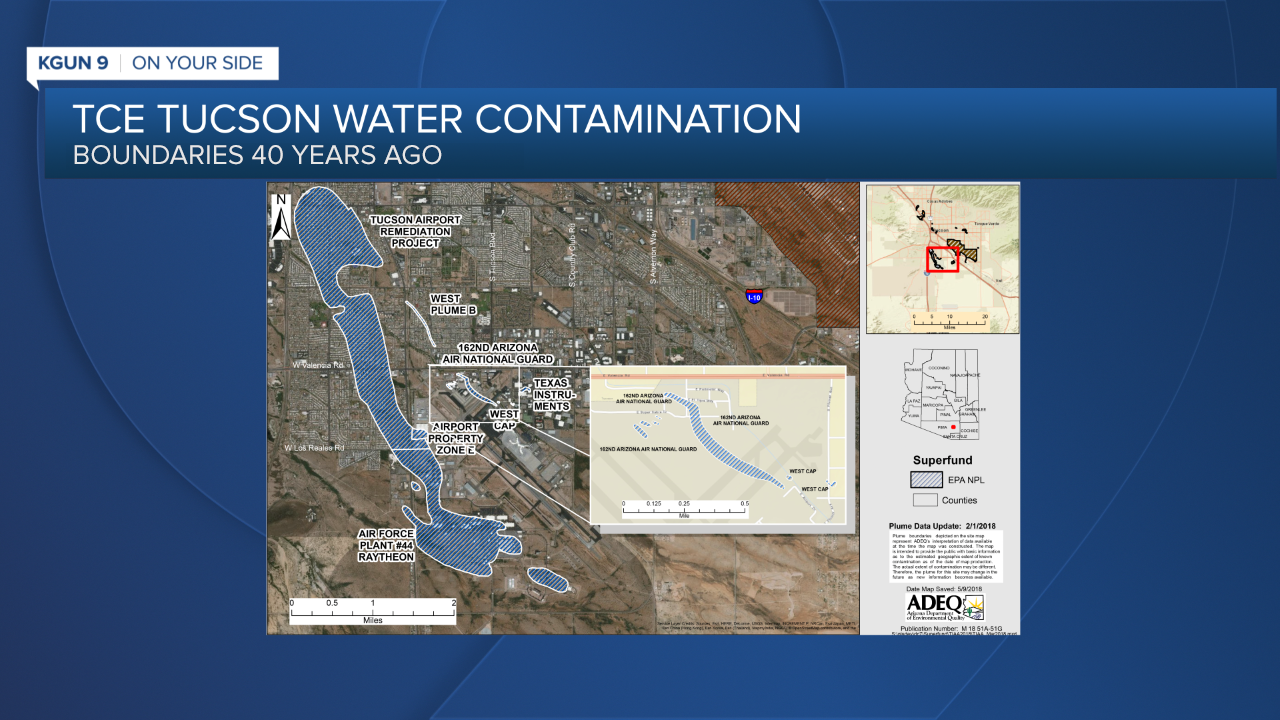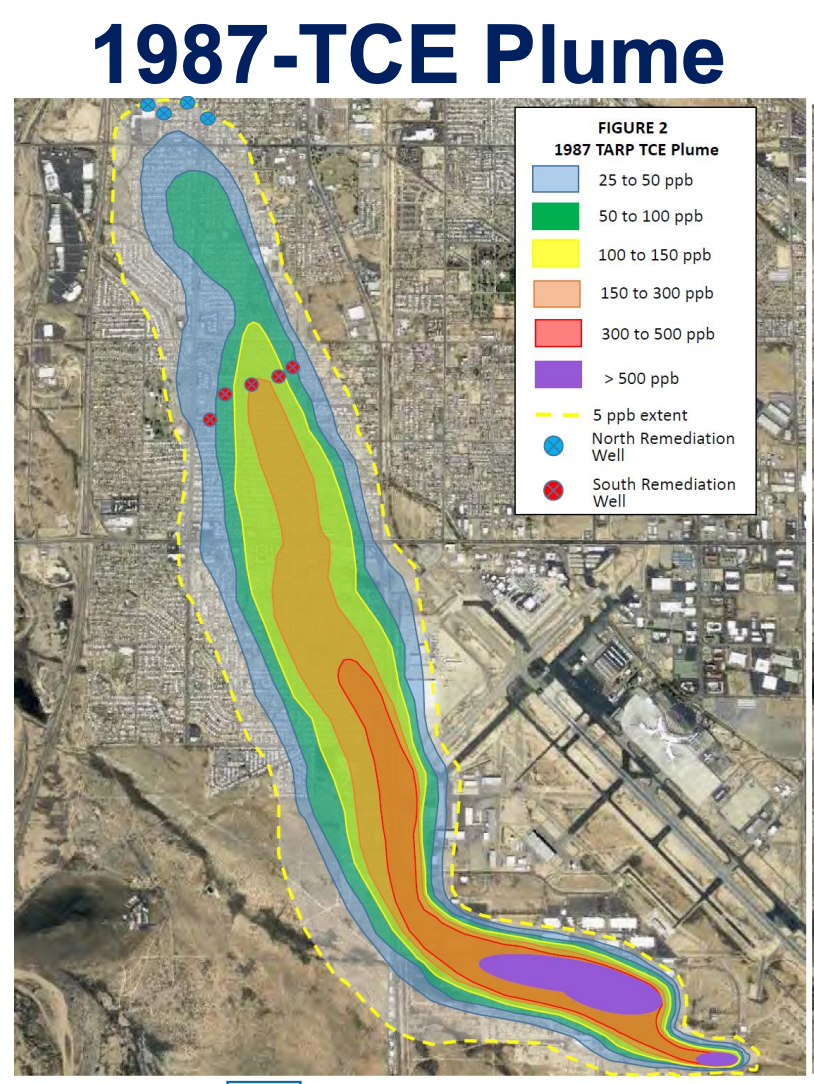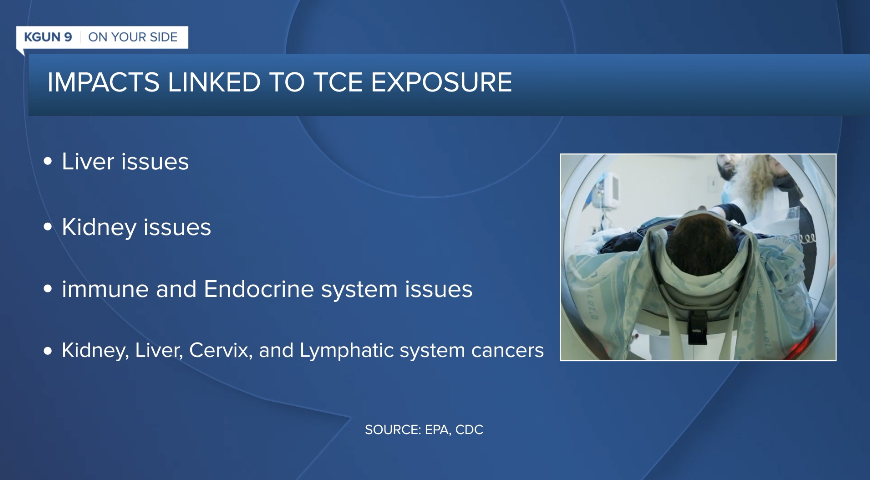TUCSON, Ariz. (KGUN) — Before the 1980s, families on Tucson's southside did not think much about drinking from the tap -- until the Pima County Health Department found out the water became contaminated.
40 years ago, high levels of trichloroethylene, or TCE, were found in the water. It was a solvent used to clean airplanes.
Residents started getting sick and at the time it led to one of the biggest water lawsuits in the country.

The area impacted was south of 22nd Street, north of Los Reales Road, east of I-19 and west of Del Moral Boulevard.
“My mom, every morning, she would run the tap water for five minutes," recalled Pattie Daggett. "She would never let us drink out of it. We always wondered why."
She and her family were one of the hundreds who felt the wrath of the TCE water contamination. In 1987 when Tucson water took over operations, some areas of the plume were severely impacted.

"I KNOW WHAT THIS WATER DID..."
The contamination led to two major lawsuits. One was against the Tucson Airport Authority and the other was against Hughes Aircraft Company.
Daggett and her family were a part of one of the lawsuits filed.
“I know what this water to did myself and all those people that swam in here every day. It's heartbreaking,” she said.“We were out [in the pool] from the time that the sun came up until the time the sun went down. We had races in here [and] pool parties in here.”
Her love for the water even led her to a lifeguard job at the neighborhood pool, but all those good memories were overshadowed by what was to come.
"I was diagnosed with a blood cancer called multiple myeloma. It's similar to leukemia. And I had to go through intense treatment. Three rounds of intense treatment because I relapsed three times,” she said.
Several types of illnesses and cancers are associated with TCE exposure.

Daggett said her treatments have cost her upwards of $90,000 per session.
As a result of the lawsuit, those at fault settled for a payout of $130 million dollars combined. Daggett walked away with $8,000.
"I TOOK THE CASE AND RAN WITH IT..."
Rick Gonzales was on the team of lawyers that represented hundreds of Southside residents.
"It was the first time the southside had ever stood up and said 'no,' you know, there's something wrong here," said Rick Gonzales, lawyer.
He was a southside resident himself who was impacted.
"That water would run off into an arroyo that ran adjacent to the Airport Authority, and between the Nogales Highway. We used to ride our bikes over there to the water was blue, it looked, it was clean, it was summer. [It was] the closest thing we had to a pool, and we would swim in it. But we didn't know we were swimming in TCE" he said.
But if you asked Gonzales if he knew what he was getting into when he took on the case, he’d tell you "no."
“I took the case and ran with it because I didn't know any better. I was a criminal defense lawyer,” said Gonzales.
Gonzalez got involved after his wife at the time was skeptical about how many people on the Southside were getting sick.
“The reason I pushed it -- totally knowing nothing about mass tort litigation -- was because these were people that were that were sick were people that I grew up with,” he explained.
THE FRYE RULE
Working tirelessly on the case for years, Gonzales and colleagues were able to put together a medical team and blue-ribbon scientific team.
"We had a medical team to identify the injuries-- the medical injuries and there were numerous. It wasn't just cancer. It was a number of them. And we also had a blue-ribbon scientific team that talked about how the groundwater, the TCE was percolating from unlined ponds down into the groundwater,” said Gonzales.
He said the turning point in the case was a deposition from a Hughes employee.
“Hughes knew about the contamination. They knew it was going to get into their groundwater, and that was one of the key questions. And the reason they knew was because they had ordered up their own environmental team -- the scientists on-premises -- because they knew that the water was percolating down,” said Gonzales.
With all the evidence and experts stacked, he truly believes his team got the results they did because of a rule that has since changed. "The Frye Rule" allowed a grand jury to listen to expert testimonies from both sides and decide which is better accepted.
"Once we got that ruling Hughes was not willing to let the case go to trial because they felt that under the circumstances, and with all the information that we had compiled, the decision would go against them. That's what led him to finally settle the case,” said Gonzales.
To this day, he said he takes calls from Tucsonans still feeling the impacts that weren’t able to file in the original lawsuit because they didn’t know about it or they moved away from the area.
But he knows the case won’t stand in court because as he explains the Supreme Court did away with the Frye Rule and brought in what’s now known as the "Daubert Standard," which puts a judge in charge of deciding if expert opinions are generally accepted in the scientific community.
“If a judge looked at that -- had we had Daubert at the time -- if Judge Browning had looked at our testimony, he could very well have said 'Mr. Gonzales, Mr. Baron, I hear your argument, I hear what your experts are saying, but I don't see any evidence that your theory and your opinions are generally accepted in the scientific or medical community as it relates to TCE,'” he explained.
"I WISH THIS NEVER HAPPENED"
However, the rules haven't stopped Pattie from continuing to fight. She took steps to file against the U.S. Air Force in 2017 but was told no.
“I received a letter after almost two years of filing that, from the air force base, saying that they denied my claim and that there's no proof of negligence or damages in this case," she said. "Which, if you drive around here, there's lots of proof."
At the end of the day, she just wishes it never happened.
"I wish this never happened to your families. And I wish you'd never had to suffer. And I really hope that somebody finally takes accountability for what's happened out there," said Daggett.
Lots of processes have changed. The nine contaminated wells are now closed. Today, Tucson Water said no contaminants can be detected in the water. The contamination resulted in a "super fund," paid by the parties responsible for the clean-up process.
One thing that comes out of the Super Fund is the TARP project. Tucson Water spends an estimated $1 million every year to clean it up. The remediation project used an air stripping process, according to Tucson Water.





